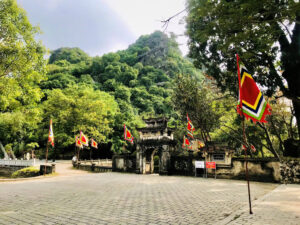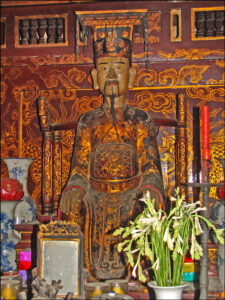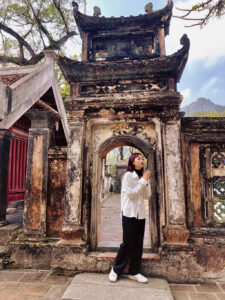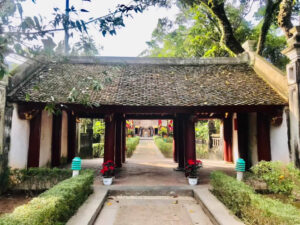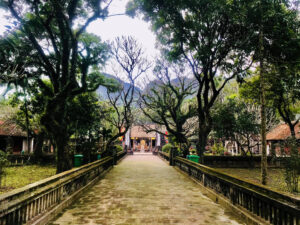These ancient temples honoring the founders of the Dinh and Le dynasties are two of the oldest and most sacred structures in Hoa Lu. Unusual for Vietnam, the two temples are only a short distance apart. Generally speaking, the temples and monuments of different dynasties are separated due to conflicting rivalries and beliefs. However, Dinh Bo Linh and General Le Hoan had an uncommonly close relationship.
Dinh Bo Linh, also known as Dinh Tien Hoang, fought and united the 12 warring states of Vietnamese pre-history. Unfortunately, assassins took his life and that of his older son while they were sleeping, ending his reign after only 11 years. Despite another, younger son being next in succession, he was deemed too young to rule.
To fill the gap in leadership, Bo Linh’s former Military Commander, General Le Hoan, promptly became the Emperor Le Dai Hanh, married the dead king’s widow and founded the early Le Dynasty. This dynasty continued many of the reforms and wishes of Dinh Bo Linh so in someways is seen as a continuation of the Dinh Dynasty.
Dai Co Viet
Because the Dinh/Le Dynasties were linked in such an unusual and intimate way, both together are often credited as the forefathers of modern Vietnam. Certainly both were instrumental in creating and protecting the medieval state of Dai Co Viet, uniting the different clans and driving out the Northern invaders.
The temples represent more than just historical recognition given by antiquarians. The buildings demonstrate the respect and admiration that these two most pivotal Vietnamese legends received from their own contemporaries and continue to receive after countless generations. Together, the two kings and their shared Queen forged a new nation that would influence Southeast and Northern Asia for centuries to come.
Restorations
Throughout their history, the ancient temples honoring the founders of the Dinh and Le dynasties have suffered damage and destruction due to various wars, floods, typhoons, and possible vandalism by rival clans. The temples were originally constructed in the 11th century, and over the years underwent considerable reconstruction, particularly during the late 1600s, and later in the 1700s and 1800s under the Later Le, the Tay Son, and Nguyen Dynasties.
Some of the restorations were quite dramatic. For instance, during the Later Le Dynasty, the temple’s original northern aspect was repositioned to face East. In 1898, the temple underwent a full restoration, leaving the Eastern aspect intact but remodeling the pillar rocks in the Nguyen Dynasty style and adding a stone threshold.
Although the “Dinh” Temple is larger, both temples are similar in style. Both were created in the ancient architectural philosophy of Noi Cong (工) and Ngoai Quoc (国), or “domestic and foreign.” Simply put, the internal building design is based on the Chinese character “工,” while the external landscaping and garden design emulate “国.” This architecture is common in many ancient Vietnamese temples and pagodas in Hoa Lu. To extend the symbolism further, the entrance road reputedly takes the shape of the letter 王 (meaning “King”)
Dinh Tien Hoang Temple
The “Upper” Temple, or Dinh Tien Hoang Temple, is a vast complex spanning an area of approximately 5 square kilometers, comprising of courtyards, gardens, and a lake. At the entrance, visitors will see a stone pillar inscribed with the Chinese characters “Bắc môn tỏa thược,” meaning “The Door to the North is Locked,” alluding to the defeat of the invaders from the North.
Approaching the temple, one is struck by the beauty of the lichen-covered stone against the backdrop of the towering Ma Yen (Horse Saddle) mountain that looms above. The site is set in lush natural surroundings and against a deep blue sky creates a vibrant and lively atmosphere that reflects the deep reverence accorded to this prosperous and pivotal dynasty throughout history. The aroma of incense still permeates the air, honoring the heroic Vietnamese people who have battled for millennia and learned to cherish peace and prosperity above all.
Architecture
On entering the temple, visitors will come to the royal courtyard, which contains two large pillars and two Vietnamese Nghe (lion dogs) statues . The Nghe serve as guardians and are positioned at either side of the ceremonial carved stone royal “bed” (Long Sàng). The royal bed is decorated with carved stylized flower motifs and features a finely detailed Vietnamese dragon at it’s center.
The temple’s main building is divided into three sections and features the triple arches of traditional Vietnamese architecture. Interestingly. the Three Gates here may be the oldest known example of this particular construction style and passing through them, you are said to have moved from the outside world to the Buddhist domain.
Upon entering the temple, the first section visitors will encounter is the Ceremonial or Ancestor rooms used for general prayers. The second section, Thien Huong, is dedicated to prayer and reverence for the four mandarins of the Dinh dynasty, which reflects the Confucian mores of the time. The final and most crucial innermost sanctum contains a bronze statue of Dinh Tien Hoang, flanked by the altars of his three sons – Dinh Lien, Dinh Toan, and Dinh Hang Lang.
Behind the temple stands the 200m high Ma Yen Mountain, known as “Saddle Mountain” due to its two peaks and low central area that is said to resemble a horse’s back. Stone steps, adorned with Buddhist symbols and figures, lead to the burial tomb and a shrine for Dinh Bo Linh (King Dinh Tien Hoang) built from local gray stone. From the peak, visitors can enjoy a panoramic view of Hoa Lu, the ancient capital of a nation forged in war and struggle.
Lê Đại Hành Temple
The adjacent temple of King Lê Đại Hành is often referred to as the Ha (“Lower”) temple and is smaller in size. The early Le dynasty owes much of its success for continuing the core constructs formulated during the short Dinh period. A wise decision judging by the subsequent success of the Vietnamese nation.
The design of the Le Dai Hanh memorial and prayer house follows much the same design as the Upper (Dinh Tien Hoang) temple. Due to the wealth of artifacts discovered through the various renovations, a small museum has been added to house the various items. The center piece is a “statue” of Queen Duong Van Nga who the long serving wife of both kings and a much loved and revered figure in Vietnam in her own right..
During the large festival that takes place on the third new moon of the lunar calendar, usually falling around March, the Dinh-Le temples are the center attraction. If you plan your trip accordingly or happen to be in the area during the festival, this is an event that you should not miss.
Truong Yen, one of the oldest continually inhabited areas in Vietnam, offers an excellent opportunity for visitors to delve into the spiritual and social history of Vietnam. Many pagodas in the village showcase some of the oldest architecture in Vietnam, including Nhat Tru Pagoda, the temple of Princess Phat Kim (daughter of King Dinh Tien Hoang), Thien Ton Pagoda and Cave, and Am Tien Pagoda. It should go without saying that visitors should wear appropriate clothing and behave respectfully as these sites hold great religious and historical significance for the Vietnamese.
Travel Tips
Tours and taxis typically know about Hoa Lu, the Dinh-Le Temple, and Truong Yen village. The shortest route from Ninh Binh City to the temple complex is about 7km. However, the Hoa Lu Ancient City covers an area of approximately 100 km2. The Dinh-Le complex, located in Truong Yen Commune to the north, is the most renowned site within the Ancient City, and it’s not accessible to motorised traffic. It is advisable to wear comfortable shoes, bring water, and wear a hat during the visit.
Getting to most sites outside of the main complex is easy as good all-weather roads connect them. However, accessing some of the more remote destinations may require navigating dusty and/or muddy roads. To navigate the more remote destinations, Google Maps and Translate are essential tools but be warned – internet can be patchy in remote Ninh Binh so download the relevant maps to your phone beforehand.
Adults pay an entrance fee of 20,000 VND to enter the Dinh-Le Temple, and motorbike parking costs 20,000 VND per vehicle. Car parking ranges from 40,000 to 50,000 VND per vehicle. Hoa Lu, its nationally revered Dinh-Le Temple, and Truong Yen Village are well-known to most tours and taxis, and ride-sharing apps like Grab who provide fixed fares.

